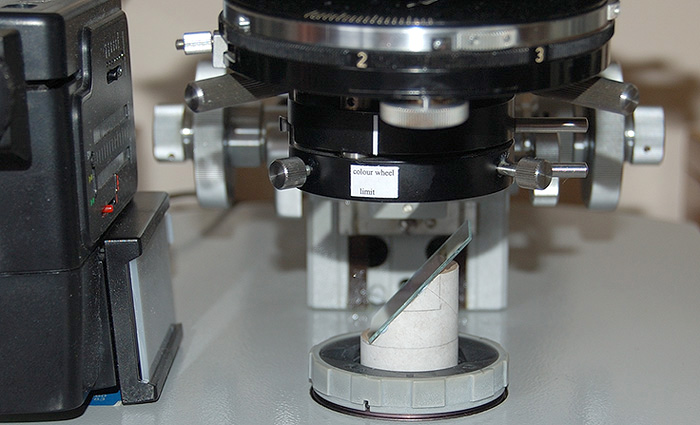A simple beam splitter made from a cardboard tube and 50/50 commercial beam splitter. A microscope slide can be used is less efficient.

Topical Tip: A simple flash / tungsten lighting setup for a microscope with built in base lamp.
by David Walker, UK
Having a combined tungsten and flash lighting set-up on a microscope is extremely useful e.g. for studying / photographing live subjects or for ensuring that potential vibration in the photomicrography setup doesn't affect the image quality. Consistent light quality is another benefit of flash which can be particularly useful when using colour films. A variety of dual lighting designs have been reported; using a glass plate or half silvered mirror at 45° as a beam splitter is one well established method and is relatively easy to set-up. Below is just a simple implementation of this design (but probably not new) that works well on my Zeiss stand, so may suit other stands.
At its simplest, all that is required is a microscope slide and stiff card tube that can sit on the lamp base. In my case, Tesco's aluminium foil center tube was the right diameter (27 mm O.D.).
A 45° surface is cut at one end of the tube and the tube is cut to a length that will present the plate at the right height for the flash gun sitting to one side. The plate can be glued on or held with four small blobs of Blu-Tak / Plasticine; the latter allows a slight correction of angle if required. A diamond scriber knife can cut the slide to suit or one of the larger coverslips may suffice although will be rather more delicate.
Of course the big disadvantage of just using glass as the beam splitter is its inefficiency. By comparing the exposure required by placing the flashgun under the condenser and with the glass as beam splitter, I was losing flash power equivalent to 3½ stops for the latter. With a SunPak 2400 flashgun with six power settings, brightfield work presented no problem, but for more light demanding applications such as polar and phase, the system was inefficient.
I therefore bought a 50/50 good quality glass beam splitter 40 x 25 mm (described as a 'dielectric' design) from www.knightoptical.co.uk for £20. These are quite expensive but as a one-off purchase was worthwhile (I did try one of their economy beam splitters but didn't find it of much benefit over an untreated glass plate). Scientific surplus suppliers may have cheaper options such as half-silvered mirror offcuts. As expected, only ca. 1 stop was lost using this as beam splitter and is shown together with notes on its use below.
Comments to the author David Walker are welcomed.
Footnote: For microscopes with a mirror and external lamp, a quite effective dual tungsten / electronic flash setup can be readily designed by exploiting two fixed angles of the mirror to point at either the flash or tungsten lamp, as shown here for a LOMO Biolam.
|
A simple beam splitter made from a cardboard tube and 50/50 commercial beam splitter. A microscope slide can be used is less efficient. |
|

|
The 50/50 beam splitter on the field lens base of a Zeiss stand. The card support tube sits snugly on the base, self aligns and doesn't interfere with either the field iris control or blocks any tungsten light when field iris at full aperture. The SunPak flashgun sits on the base (seen left) at correct height without affecting microscope operation. Using a tube as a support for the splitter is intrinsically sturdy and encroaches less than a bulkier box section design might do. With microscope lamp on full power, a feint image of the field iris is projected left onto the flashgun diffuser which allows a quick check of flashgun alignment. In use, the tungsten lamp can be turned down to a level good enough for visual studies but low enough not to affect the camera exposure with flash (a high flash sync setting on the camera helps; it is 1/250th sec. on the author's Nikon D50 DSLR). On the author's Zeiss stand, probably more by luck than design, when the condenser was correctly focussed on the field iris for built in Köhler lamp use, it was also focussed on the diffuser panel for the flashgun, so akin to critical illumination. When flash lighting isn't required, the flashgun and beam splitter can be quickly stored and reinstated when desired with no critical setting up required. For photographing prepared slides, there is enough space on this stand to place the flashgun directly under the condenser, as described in an earlier article, but a beam splitter design has advantages. |
|
The diatom Stauroneis phoenocenteron in Hyrax, Klaus Kemp 'Test plate 8 forms'. Zeiss 100x Neofluar objective NA1.30, brightfield with slight oblique, dark green filter. Nikon D50 DSLR at 400 ASA. Photomicrography at the highest powers, especially with a DSLR with focal plane shutter and no mirror lock can be prone to vibration; electronic flash removes this possibility. The beam splitter described above was used; the flashgun was on 1/8th power so plenty in reserve e.g. for phase at this mag. |
|
Published in the June 2007 edition of Micscape.
Please report any Web problems or offer general comments to the Micscape Editor .
Micscape is the on-line monthly magazine of the Microscopy UK web site at Microscopy-UK
© Onview.net Ltd, Microscopy-UK, and all contributors 1995
onwards. All rights reserved.
Main site is
at www.microscopy-uk.org.uk
with full mirror
at www.microscopy-uk.net
.